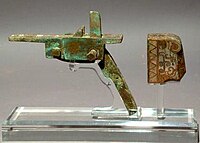
Photo from wikipedia
Additive manufacturing (AM), also known as 3D-printing (3DP) technology, is an advanced manufacturing technology that has developed rapidly in the past 40 years. However, the ceramic material printing is still… Click to show full abstract
Additive manufacturing (AM), also known as 3D-printing (3DP) technology, is an advanced manufacturing technology that has developed rapidly in the past 40 years. However, the ceramic material printing is still challenging because of the issue of cracking. Indirect 3D printing has been designed and drawn attention because of its high manufacturing speed and low cost. Indirect 3D printing separates the one-step forming process of direct 3D printing into binding and material sintering, avoiding the internal stress caused by rapid cooling, making it possible to realize the high-quality ceramic component with complex shape. This paper presents the research progress of leading indirect 3D printing technologies, including binder jetting (BJ), stereolithography (SLA), and fused deposition modeling (FDM). At present, the additive manufacturing of ceramic materials is mainly achieved through indirect 3D printing technology, and these materials include silicon nitride, hydroxyapatite functional ceramics, silicon carbide structural ceramics.
Journal Title: Journal of Central South University
Year Published: 2021
Link to full text (if available)
Share on Social Media: Sign Up to like & get
recommendations!